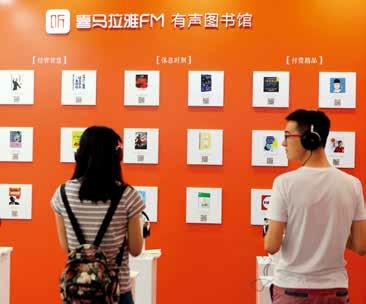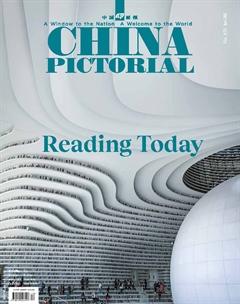Reading Behind the Lines
by Zhou Xin
In 104 B.C., Sima Qian began to compile a history of China from prehistoric times to the period of Emperor Wu(156-87 B.C.) of the Western Han Dynasty (202 B.C.-9 A.D.). Back then, paper had not yet been invented, and writing was done on bamboo slips. After writing on a number of single bamboo slips, the author connected the dried bamboo slips in sequence, rolled the chain up, and then picked up new bamboo slips and repeated the procedure.
Sima Qians book, Records of the Grand Historian, has more than 520,000 Chinese characters and was hailed as “a masterpiece of the ages” by renowned Chinese writer Lu Xun (1881-1936). It is estimated that the monumental book took about 20,000 bamboo slips, so several rooms might be needed just to store a single title.
China has a long history of written communication. For thousands of years, the wisdom of the sages and the history of each dynasty were recorded with written language. Whether the carrier was bamboo slips or paper, the vast sea of writings preserved the essence of the Chinese civilization, which has been passed down from generation to generation. A Chinese idiom used to heap great praise on ones knowledgeableness goes, “His mind bears more knowledge than could have been contained in five cartloads of books.”
More than 2,000 years later, a microscopic chip can easily store the Twenty-Four Histories, a collection of books on Chinese dynastic history from about 3000 B.C. to the 17th century. The Twenty-Four Histories, said to “make the ox pulling it sweat,” can now be carried by a baby.
Reading, from carrier to consumption, is now undergoing changes unseen in thousands of years.
The Rise of E-books
Li Yang, who works in Beijing, was among the first few in China to experience reading on electronic ink screens. The avid reader felt lugging around his heavy load of paper books becoming increasingly inconvenient. In 2007, Amazon launched its first Kindle e-book reader, and Li Yang snapped one up immediately.
“We called it an electronic-paper book at the time,” Li said. The 6-inch, palm-sized e-book reader was not only light and portable, but also offered a screen designed to provide a reading experience close to that of a physical book. The screen was easier on the eyes than normal electronic screens.
The early e-reader only had four gigabytes of storage, which was already enough to hold many e-books. And while reading an English book, a Chinesespeaking reader can see a Chinese translation instantly with a click, which greatly improves the speed of reading.
Electronic readers have gradually been embraced by more and more people. From iReader, China Literature, and JD.com to Dangdang.com, Chinese domestic producers quickly caught up and released their own e-book readers.
Although e-book readers still boast multiple advantages, larger screens and better apps on smartphones have made the reading experience on a primary device on par with using an e-book reader.
According to the 2020 National Reading Report released by Amazon China, 46 percent of people read both paper books and e-books, and 29 percent mainly read e-books, an increase of 6 percent from the previous year. In addition, 72 percent of readers believe that digital reading has helped them increase their total reading volume.
Bookish Interaction
A loyal fan of the e-book app WeChat Read, Zhang Wenwen has read 102 books through the app since 2016, covering a wide range of genres including literature, philosophy, work efficiency, and wealth management. The app enables her to share the books she has read through a virtual bookshelf and compare with her daily time spent reading with that of her friends.
The WeChat Read app was a latecomer in the e-book market. It rolled out in 2015 when various reading apps had already been established. However, the app boasts a unique advantage: It bridges the reading experience to social connections by working seamlessly with WeChat, one of Chinas most popular chat apps.
“Socialized reading is an important means of social interaction,” said Yang Jianhua, head of the Sociological Association of Zhejiang. “Sharing the reading experience is more likely to stimulate interesting discussion. The internet has made it easier for readers with similar taste in books to gather on virtual platforms.”
Like many other popular e-book apps, WeChat Read allows users to see other readers comments when reading a book.“This feature represents the scene of communicating with other readers and creates a pleasant atmosphere for sharing ideas,” said Zhang Wenwen. “I post some sentences in books I like on the app to introduce books and authors to more people.”
At the 2015 International Digital Publishing Forum, digital publishing expert Rüdiger Wischenbart argued that the book industry is becoming more driven by the reader community as the impact of social media on books has expanded; and some literary critics who once made bestsellers with an endorsement have been shaken from their dominant positions.
Momentum of Audiobooks
Reading the monumental novel Dream of the Red Chamber, considered the pinnacle of classical Chinese literature, is a “mission impossible” for many occupied readers. For Wu Yue, mother of a four-year-old, reading the novel seemed like a daunting task, but she easily finished listening to it on an audiobook app.
Audiobooks are ideal for the fast-paced and high-pressure society populated by those with little time to read. “Audiobooks allow users who dont have enough time or dont like reading paper books to engage in reading in an easier and simpler way,”said Fan Deng, founder of the audiobook platform Spiritual Wealth Club.
According to iiMedia, a data mining and analysis firm, the scale of Chinas audiobook market was around 6.36 billion yuan(US$978 million) in 2019, and the number of users rose from 218 million in 2016 to 478 million in 2019. The three most popular Chinese audiobook platforms, Himalaya FM, Qingting FM, and Lanrentingshu, have over 10 million monthly active users each. According to a report on the global audiobook market released at the Frankfurt Book Fair, China is expected to become the largest audiobook market in 2022.
However, some dont regard audiobook listening as real reading. Devoted fans of paper books believe that the cost of reading paper books today is already very low, and audiobooks reduce the cost to almost zero: You dont have to buy books or reading equipment, or to squeeze in time to concentrate. This kind of extreme availability makes books accessible to everyone but at the same time dispels the serious aura of reading. Readers may gradually lose interest and patience to appreciate serious works if they become accustomed to listening to books digested and read by others.
Nevertheless, with traditional methods of reading becoming a bit unfit for fast-paced life in the modern era, the ways and means of reading must change, and one could do worse than listen to audiobooks. “Books were limited to paper in the past, but thanks to technological advancements, today readers can enjoy many different experiences such as engaging with audiobooks,” remarked Chen Pingyuan, a noted scholar at the Department of Chinese Language and Literature, Peking University. “If a paper book is read out to be heard and loved by many, that means it is a good book.”

